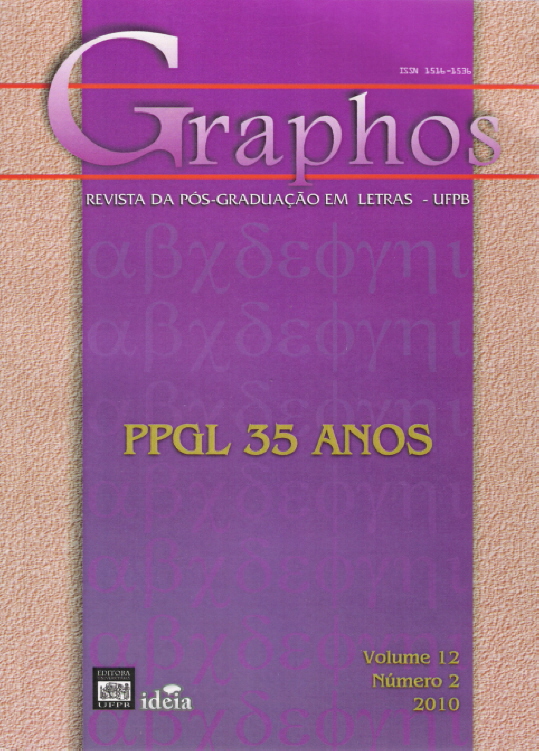Variantes diatópicas e diastráticas na língua portuguesa do Brasil
Keywords:
Linguistic variation, Learning of the portuguese language, Linguistic prejudiceAbstract
This work tries to show that the description of the Portuguese language in its various
diatopic and diastratic variations, in the various levels of the linguistic analysis, from the phoneticalphonological
to the lexical, from morphosyntactical and to the semantical, is one of the most
important and urgent, in order to provide a true picture of the Portuguese language spoken in written
in our country. The prejudices and stigmas that surround these variations make them to be
considered wrong, with no prestige and therefore, avoided or even banished from the didactical
books and from classrooms. This, if transferred to Fundamental and Medium Teaching Schools,
from poor regions, with students of lower socio-economic-cultural levels, cause, in the great
majority of times, the so called “ linguistic traumas “ , once the language taught in the school could
be considered as a foreign language for the student. It is also discussed the theories that are the basis
the teaching/learning of languages and its possible solutions for the existing problems referring the
Portuguese Language.
Downloads
References
AGUILERA, Vanderci A. “O fonema / /: realização fonética, descrição e sua comparação na fala popular paranaense.” In: III ENCONTRO NACIONAL DE FONÉTICA E FONOLOGIA. Anais. João Pessoa: UFPB, 1988.
ARAGÃO, M. do Socorro Silva de. “Variantes regionais e o ensino de 1º grau.” In: Caderno de Letras. João Pessoa: (4): 57/77, jul. 1979.
_____. et al. O conto popular na Paraíba: um estudo linguístico gramatical. João Pessoa: UFPB, 1992.
_____. MENEZES, Cleusa P.B. de. Atlas linguístico da Paraíba. Brasília: UFPB/CNPq, 1984, vol. 1 e 2.
BARBOSA, M. A. Léxico, produção e criatividade: processos de neologismo. São Paulo: Global, 1981.
_____. “O léxico e a produção da cultura: elementos semânticos.” In: I ENCONTRO DE ESTUDOS
LINGUÍSTICOS DE ASSIS. Anais. Assis; UNESP, 1993.
BERNSTEIN, B. “Comunicação verbal, código e socialização.” In: COHN, G. (Org.) Comunicação e indústria cultural. São Paulo: Nacional, 1971, p.83-104.
_____. “Estrutura social, linguagem e aprendizagem.” In: PATTO, M.H.S. (Org.) Introdução à psicologia escolar. São Paulo: Queiroz, 1982, p. 129-51.
_____. “Uma crítica ao conceito de educação compensatória.” In: BRANDÃO, Z. (Org.) Democratização do ensino: meta ou mito? Rio de Janeiro: Francisco Alves, 1979, p. 43-57.
BERRUTO, G. La sociolingüística. México: Editorial Nueva Imagen, 1976.
BIDERMAN, M.T.C. Teoria linguística (linguística quantitativa e computacional). Rio de Janeiro: Livros Técnicos e Científicos, 1978.
_____. “Léxico, testemunho de uma cultura.” In: CONGRESSO INTERNACIONAL DE
LINGUÍSTICA E FILOLOGIA ROMÂNICA, XIX. Anais. Santiago de Compostela, 4/9/ de setembro, 1989.
BISOL, L. “Fonética e fonologia na alfabetização.” In: Letras de Hoje. Porto Alegre: (17), 32-39, set. 1974.
BITTENCOURT, Agueda B. “Como será a educação da próxima geração.” In: Folha [Sinapse]. Folha de São Paulo, 26 de julho de 2003, p. 10.
CALVET, Louis-Jean. La sociolinguistique. Paris: PUF, 1993. CÂMARA JR., Joaquim Mattoso. História e estrutura da língua portuguesa. Rio de Janeiro: Padrão, 1979.
_____. Estrutura da língua portuguesa. Petrópolis: Vozes, 1972.
CARDOSO, Suzana A. M. “Atlas linguístico do Brasil – AliB” In: Projeto. Salvador: UFBA, 1998.
CHAMBERS, J. K.; TRUDGILL, P. Dialectology. Cambridge: Cambridge University Press, 1980.
DITTMAR, B. Sociolinguistics: a critical survey of theory and application. London: Arnold, 1976.
FERREIRA, Carlota et al. Atlas linguístico de Sergipe. Salvador: UFBA - Instituto de Letras/Fundação Estadual de Cultura de Sergipe, 1987.
_____. Diversidade do português do Brasil - estudos de dialetologia rural e outros. Salvador:
UFBA, 1994.
GARMADI, J. La sociolinguistique. Paris: PUF, 1981.
GILES, H & POWESLAND, P.F. Speech style and social evaluation. London: Academic Press, 1975.
GREIMAS, A.J. & COURTÉS, J. Dicionário de semiótica. São Paulo: Cultrix, 1981.
HUDSON, R. A. Sociolinguistics. Cambridge: Cambridge University Press, 1984.
LABOV, W. Language in the inner city. Philadelphia: University of Pennsylvania Press, 1972, Cap. 5.
LEMLE, Miriam. “Heterogeneidade dialetal: um apelo à pesquisa.” In: Tempo Brasileiro. Rio de Janeiro: 53/54): 69-94, abr./set. 1978, p. 60.
MARCUSCHI, L. A. Da fala para a escrita: atividades de retextualização. São Paulo: Cortez, 2001.
MOLLICA, M. C. A influência da fala na alfabetização. Rio de Janeiro: Tempo Brasileiro, 1998.
_____. Da linguagem coloquial à escrita padrão. Rio de Janeiro: 7 Letras, 2003.
MORALES, H. L. Sociolingüística. Madrid: Gredos, 1993.
PERRENOUD, Philippe. “Como será a educação da próxima geração.” In: Caderno Folha [Sinapse]. Folha de São Paulo, 22 de julho de 2003, p. 11.
POTTIER, Bernard. Théorie et analyse en linguistique. Paris: Hachette, 1987.
ROSSI, N. Atlas prévio dos falares baianos. Rio de Janeiro: INL, 1963.
SANKOFF, G. “Language use in multilingual societies: some alternative approaches.” In: Pride and Holmes, 1972.
SCARTON, G.; MARQUARDT, Lia L. “O princípio da variação linguística e suas implicações numa política para o idioma.” In: Boletim do Gabinete Português de Leitura. Porto Alegre: (24), 21.31, jun, 1981, p. 6.
SOARES, M. Linguagem e escola: uma perspectiva social. São Paulo: Ática, 1986, p. 42.
TASCA, M.; POERSCH, J.M. (Orgs.). Suportes linguísticos para a alfabetização. Porto Alegre:
SAGRA, 1986.
WARDHAUGH, R. An Introduction to sociolinguistics. Oxford UK & Cambridge USA: Blackwell, 1992. ZÁGARI, Mário Roberto L. et al. Esboço de um atlas linguístico de Minas Gerais. Rio de Janeiro: Fundação Casa de Rui Barbosa, 1977.







